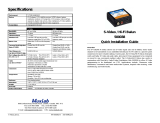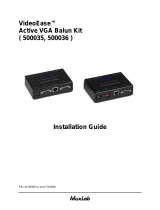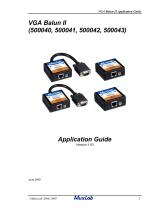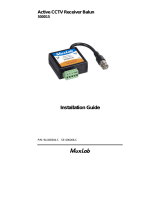MuxLab Distribution Amplifier DA1506RT Installation guide
- Category
- Audio amplifiers
- Type
- Installation guide
This manual is also suitable for

VideoEase VGA Balun Application Guide
©MuxLab 2004-2007 1
VideoEase VGA Balun
(500010, 500011, 500014)
Application Guide
Version 1.39
Feb 2007
500010
500011
500014

VideoEase VGA Balun Application Guide
©MuxLab 2004-2007 2
Purpose
The purpose of this document is to explain how to apply the VGA Balun under different
operating conditions and to discuss issues not covered in the Installation Guide that
comes with the product.
Function of the VGA Balun
The function of the VGA Balun is to allow the traditional VGA cable to be replaced by
Category 5 (or better) twisted pair, thereby allowing VGA display screens to be located
up to 450 feet from the source, exceeding standard VGA cable distance limitations. The
VGA Balun finds applications in the following areas:
Multimedia Projector Systems: Allows the multimedia projector to be placed at
extended distances from a laptop or PC in a conference room or training room
environment. Allows the presenter to stand at a distance from the projector so as not to
obstruct the view of its audience.
Classroom PC Instruction: Allows a CRT monitor or projector to be connected to an
instructor’s PC via cost-effective Cat 5 twisted pair cable.
Video Information Systems: Allows display monitors or flat-screens to be distributed
throughout a complex via pre-installed Cat 5 twisted pair cable.
Industrial Process Monitoring: Allows CRT monitors or flat-screen displays to be located
at a remote distance from the central processor via pre-installed Cat 5 twisted pair.
PC and keyboard
CRT Monitor
500014
Laptop computer
500014
Laptop computer
Multimedia
Projector
500011
500010
Category 5 4-Pair
Shielded Twisted Pair
Flat-screen Monitor
Shielded RJ45
connector
Shielded RJ45
connector
Multimedia
Projector
VGA balun
Instructor's PC
1x2 VGA
Splitter/Amplifier
VGA cable
500010
500010
500010
500011

VideoEase VGA Balun Application Guide
©MuxLab 2004-2007 3
Equipment With Which the VGA Balun Works
The VGA Balun works with any equipment that supports VGA, XGA or SVGA signals,
including; PCs, laptops, multimedia projectors, CRT monitors, flat-screen LCD monitors,
plasma displays, VGA signal boosters, VGA signal splitters and VGA scan converters.
Application Table
There are currently three (3) product items in the VGA Balun range. The following table
summarizes their application
Part Connector Usage
500010 DB15HD Plug VGA - PC Side*
500011 DB15HD Receptacle VGA - Monitor Side
500014 DB15HD Plug VGA - Monitor Side
*The 500010 is electrically different from the 500011/500014.

VideoEase VGA Balun Application Guide
©MuxLab 2004-2007 4
When Must Shielded Twisted Pair (STP) Be Used
Cat 5 Shielded Twisted Pair must be used with the VGA Balun when either the VGA
source or destination equipment does not have a built-in 3-prong power plug. This is due
to the fact that the VGA Balun requires a reliable ground on both sides of the connection
to transmit the horizontal and vertical synchronization signals. If the equipment is not
properly grounded, then a common reference point must be supplied by using shielded
twisted pair cable. Furthermore, the STP cable must be terminated with shielded RJ45
modular plugs on both sides. The outer cladding of the shielded plug makes contact with
the shield of the RJ45 jack in the VGA Balun to provide a continuous ground. The
following photos show a shielded RJ45 plug and the spliced end of a Cat 5 STP cable.
Note the four twisted pairs, the foil shield and the drain wire. The foil shield and drain
wire must be fold back on the cable and then crimped inside the RJ45 plug along with the
other conductors. The foil shield and drain wire must make contact with the shield of
the RJ45 plug. The last photo shows the finished connection. For more information
please refer to page 7 of Tyco Electronics (AMP) Application Specification 114-6016. A
copy of this document is available from MuxLab on request.
Typically, laptops, some multimedia projectors and flat-screen LCD monitors do not have
built-in 3-prong power plug but rather are sold with external power adapters. In these
cases, shielded twisted pair cable must be used. If STP is not used in these
situations, the result will be a total or intermittent loss of picture. The following table
summarizes the type of cable required based on the connection configuration.
Destination
Source CRT LCD
Flatscreen
Multimedia
projector
Plasma
display
Desktop PC UTP* or STP STP STP STP
Laptop STP STP STP STP
* Note: STP may be required when a desktop PC is connected to a CRT monitor if:
a) the AC ground of CRT is different from the AC ground of the PC or
b) the AC outlet of the CRT or PC is not grounded at all.
c) there is an absence of signal ground continuity between the two baluns.

VideoEase VGA Balun Application Guide
©MuxLab 2004-2007 5
Shielded Cat 5 and Shielded RJ45 Components
In order to prepare a shielded Cat 5 cable connection, the following material is needed:
Two (2) shielded RJ45 plugs
One (1) spool 4-pair shielded Cat 5 cable cut to the desired length.
One (1) Twisted Pair Cable Stripping Tool
One (1) Crimping Tool and RJ45 Die Insert.
Shielded Cat 5 cable is sold as 26 AWG stranded twisted pair or as 24AWG solid copper
twisted pair. Stranded cable is usually used for patch cables. If stranded twisted pair
is used, then RJ45 plugs for stranded cable must be ordered. If solid copper Cat 5
STP is ordered, then RJ45 plugs for solid copper twisted pair must be used (See
Tyco/AMP Application Specification 114-6016). The crimping tool crimps the drain wire
to the RJ45 shielded plug.
When crimping shielded RJ45 plugs onto shielded Cat 5 twisted pair cable, the drain wire
from the shield inserts into the RJ45 plug along with the eight (8) conductor wires prior to
crimping. When the crimping tool is compressed, all nine (9) wires will be crimped into
the plug.

VideoEase VGA Balun Application Guide
©MuxLab 2004-2007 6
Shielded Cable and Connector Sources
In order to provide a complete shielded Cat5 cabling solution for the VGA Balun, the
following table lists a few sources for shielded twisted pair cable and connectors.
Vendor Part # Description Tel Loc
Black Box FM733 Shielded RJ45 Plug for Solid Cat 5 Cable 724-746-5500 USA
Black Box FM731 Shielded RJ45 Plug for Stranded Cat 5 Cable 724-746-5500 USA
Black Box EVNSL60-20 Cat5 STP 20 ft. Patch Cable terminated with shielded RJ45 on
both ends. – 26AWG, Stranded, PVC.
724-746-5500 USA
Black Box EVNSL71-0050 Cat5 STP 50 ft. Line Cord terminated with shielded RJ45 on
both ends. – 24AWG, Solid copper, PVC.
724-746-5500 USA
Black Box EVNSL71-0100 Cat5 STP 100 ft. Line Cord terminated with shielded RJ45 on
both ends.– 24AWG, Solid copper , PVC.
724-746-5500 USA
Video Ware Shielded Cat5 Cable and Connectors
http://www.svideo.com/cat5e.html
877-857-5553 USA
Anixter CM-00424CSG-5B Belden 1624R Cat5 STP solid
http://onlinecatalog.anixter.com/
1-800-Anixter USA
Anixter CM-00424FTPD-
5B-06
Belden 1730A Cat5E STP solid 1-800-Anixter USA
Anixter CM-00424MWK-
5E-ODS
4-pair Cat5e STP – Outdoor rated - solid
Mohawk/CDT p/n M57562
1-800-Anixter USA
Anixter 214944 Shielded RJ45 plug for 24AWG solid copper shielded twisted
pair. Tyco/Amp p/n 5-569550-3
1-800-Anixter USA
Anixter 176273 Shielded RJ45 plug for 4-pair stranded shielded twisted pair
Tyco/Amp p/n 5-569542-3
1-800-Anixter USA
Graybar 99576510 4-pair 24AWG shielded twisted pair. USA
Connect
Technologies
18-1253 RJ45 shielded pass-thru jack for keystone type plates
http://www.connecttech.net/
615-726-0847 USA
Connect
Technologies
06-3755 RJ45 shielded coupler adapter. 615-726-0847 USA
My Cable
Shop
KEY110S Keystone RJ45 Shielded
http://www.mycableshop.ca/sku/KEY110S.htm
866-449-4498 CAN
My Cable
Shop
Z45-STP-STR-100 Shielded RJ45 Plug
http://www.mycableshop.ca/sku/Z45-STP-STR-100.htm
866-449-4498 CAN
Ortronics Clarity Shielded Solution
http://www.ortronics.com/us/tools/download/?dfp=lit&dfn=Cl
arityShielded.pdf
USA
Tyco 1116515-1 110connect Cat5e Shielded Mod Jack
http://www.ampnetconnect.com/documents/Enhanced_Cat_5e
_110Connect_Shielded_Jack_Cut_Sheet.pdf
800-553-0938 USA
Tyco 1339015-1 SL Series Tool-Less Cat5e Shielded Jack
http://www.ampnetconnect.com/documents/Cat_5e_Shielded_
Toolless_Jack_Cut_Sheet_rev1.pdf
800-553-0938 USA

VideoEase VGA Balun Application Guide
©MuxLab 2004-2007 7
Pin Configuration
The cable between the two VGA Baluns must respect the pin configuration of the baluns.
The twisted pairs must mate with the correct pins and the polarity must be straight-
through. That is, Pin 1 on one end must connect to Pin 1 at the other, and so on for the
other seven pins. Each of the following pin-pairs constitute a twisted pair; Pins 1&2, Pins
7&8, Pins 4&5, Pins 3&6 as shown in the following diagram.
Pair 1Pair 3Pair 2
Pair 4
VGA Balun
RJ45 Jack
1 2 3 4 5 6 7 8
Twisted Pairs
When Can Unshielded Twisted Pair (UTP) Be Used
Cat 5 Unshielded Twisted Pair (UTP) cable may be used with the VGA Balun when both
VGA Baluns share a perfect common reference ground. This is possible if both
equipment are plugged into the same AC power mains. For example most CRT monitors
and desktop PCs. Under these conditions, the user can also take advantage of pre-
installed Cat 5 UTP cable.
However, even when both devices share a common AC power ground, it is still possible
that there is no commons signal ground between the two VGA Baluns. The reason is that
the display may have internal circuitry that blocks continuity between the AC ground and
the VGA signal ground. In this case even though it appears that both baluns share a
common ground, in reality they may not.
An example would be if the internal power supply of the equipment does not transfer the
AC ground to the VGA signal ground. Or there may be noise blocking circuitry between
the AC ground and the VGA ground. One would need to be familiar with the internal
design of the monitor to verify this. This may be one reason why one monitor may work
with UTP and another monitor may not. In this case shielded twisted pair must be used
even though both VGA devices are plugged into the same 3-prong AC power source.

VideoEase VGA Balun Application Guide
©MuxLab 2004-2007 8
How to Provide a Common Ground if UTP is Used
In the event that UTP has already been installed and it is not practical or feasible to install
STP cable, an alternative solution is to connect a spare wire between the VGA Baluns to
provide a commons signal ground. One method of achieving this is to use shielded RJ45
plugs at both ends of the UTP cable and to crimp or solder the extra wire to the RJ45
metal shroud. Another option is to solder both ends of the wire to the DB15HD metal
shell. This will provide a common ground path to ensure reliable signal transmission as
shown in the following diagram.
Displays Equipped with DB15HD Receptacle
Due to the product design, the VGA Balun-PC Side (500010) must be connected to the
source and the VGA Balun-Monitor Side (500011, 500014) must be connected to the
display. Most plasma and LCD screens have a DB15HD receptacle and therefore it is
recommended to use the 500014.
If this is not possible, then connect a short VGA male-to-male extension cable or gender
changer between the 500011 and the display. A photo of a typical VGA extension cable
and gender changer is shown below. The gender changer shown at the bottom right can
be found at the following link: http://www.cablesnmor.com/vga-gender-benders.html
To locate a source for a VGA extension cable or gender changer please consult the table
of VGA cabling equipment vendors provided at the end of this document.

VideoEase VGA Balun Application Guide
©MuxLab 2004-2007 9
Cable Stiffness
It has been related by several customers that when terminating solid copper STP cable at
the VGA Balun, movement of the stiffer solid copper STP cable applies excess torque on
the RJ45 plug inside the balun thereby causing intermittent contact, leading to color
changes or lost signals. Jiggling the RJ45 plug inside the balun restores the picture. In
order to avoid this problem one option is to terminate the STP cable at the wall outlet and
then to connect stranded STP jumper cords between the wall outlets and the baluns.
Picture Problems
During the installation of the VGA Balun various picture problems may result. It is
important to know what is causing these problems and how to correct them.
Total or Intermittent Loss of Image
This problem is almost always due to loss of synchronization due to improper grounding
and manifest itself by an intermittent flashing display or total loss of image. This will
occur if UTP is used with VGA equipment that does not have a built-in 3-prong power
plug. The solution is to replace the UTP by Cat 5 STP and terminate both ends with
shielded RJ45 modular plugs.
Smearing
Smearing occurs when the edge of an image leaves trail traces similar to smudging a line
of ink on a piece of paper. This may occur as the length of twisted pair cable increases.
As the maximum distance specification is neared, the physical properties of the cable and
baluns begin to show this effect. This is due to the effects of propagation delay and
attenuation. Aside from using an active device with built-in tilt-amplifier to correct the
problem, the other possible solutions are; a) to shorten the length of cable or b) adjust the
contrast and brightness of the monitor.
Flutter
Flutter occurs when the background fluctuates between light and dark. This symptom
may be due to problems with the grounding between the VGA equipment or the
connection may be picking up some external interference from a nearby power
transformer. A solution to minimize this effect is to adjust the monitor’s contrast and
brightness
Ghosting
Ghosting is characterized by a second video image being received after the main image,
resulting in a double image that is skewed in relation to the first. This is usually due to a
problem with the UTP cable connection itself. Poor crimping, untwisted pairs, some of
the twisted pairs may be longer than others, poor quality cable, or impedance mismatch

VideoEase VGA Balun Application Guide
©MuxLab 2004-2007 10
between the CPU and the monitor are all some of the causes. In these cases it is best to
replace the existing cable with a new one.
Wrong Colors
If the wrong colors appear in an image (i.e. blue appears where green should appear), the
problem may be due to swapped or split twisted pairs. The key is to verify the pin
configuration of the cable between the CPU and the monitor to ensure that the correct pin
configuration is respected. Please refer to the Installation Guide for further details about
pin configuration.
Loss of Image Detail
Loss of image detail may occur as the length of twisted pair cable increases. As the
maximum distance specification is neared, the physical properties of the cable and baluns
will begin to show this effect. This is due to the effects of propagation delay and
attenuation. Other than using an active device with built-in tilt-amplifier, one can improve
the image by shortening the length of twisted pair or reducing the picture resolution. If
the application operates adequately at a lower resolution (i.e. 800x600 instead of
1024x768), then setting the monitor to a lower resolution will help improve the image.
Another way to improve the image is to adjust the contrast and brightness of the monitor.
Loss of Image with LCD Projectors
If there is a loss of image or image detail when a PC is connected to an LCD projector, it
is possible that the screen resolution is been set too high. Try to lower the resolution to
800x600 and try again. Position the mouse on the Desktop and right-click. Select
“Properties”. Select the tab marked “Settings” and adjust the “Display Area” to
800x600. Click on “Apply” and then “OK”. Return to the original application and
check the image on the projector.

VideoEase VGA Balun Application Guide
©MuxLab 2004-2007 11
Laptop Touchpad Mouse and Image Flicker
It has been noted that when certain touchpad laptops are connected to a monitor using
UTP cable and VGA Baluns, some background flicker or flutter in the image has been
noticed when the touchpad mouse cursor is moved. This phenomena has been traced to
additional EMI/RFI noise generated by the laptop when the touchpad is activated
consequently interfering with the VGA video signal. The problem can be resolved by
replacing the UTP cable between the VGA Baluns by Category 5 shielded twisted pair
(STP) cable. In order to ensure proper shielding, at least one end of the cable shield must
be connected to ground.
Bandwidth and Operation at SXGA (100MHz)
Although the VGA Balun has a bandwidth specification of 60 MHz, it will still operate at
screen resolutions with higher bandwidth; i.e.; SXGA (100MHz). This is because the
bandwidth roll-off above 60 MHz is gradual and not sharp, allowing the higher frequency
components through.
Projectors Equipped with Wireless Mouse and USB Port
On higher-end multimedia projectors, a wireless mouse is offered that allows the
presenter to control the laptop cursor via remote control. In order to do this, the laptop
must be connected to the projector via the USB port. Due to the distance limitations of
the USB interface (16.4 feet / 5 meters), the laptop must be near the projector. This
would prevent the use of the VGA Baluns to extend the distance between the laptop and
the projector. If it is essential that the laptop be connected via twisted pair at an extended
distance from the projector then the user has two options:
B) Refrain from using the wireless mouse and rather use the laptop mouse, or
B) Buy a set of USB extenders from companies like Icron or Gefen (Icron private label).

VideoEase VGA Balun Application Guide
©MuxLab 2004-2007 12
DVI-I to VGA Adapters
The DVI-I interface is a combined analog and digital interface found on some PCs and
screens. In applications where the analog (VGA) portion of a DVI-I interface needs to be
connected to a VGA monitor, the VGA Balun may be used in conjunction with a DVI-
VGA Adapter. The adapter extracts the analog video (VGA) portion of the DVI-I
interface and converts it to DB15-HD as shown in the following picture.
Proxima 6150 Projector
It has been found that in some installations, the Proxima 6150 Projector has not been able
to synchronize when used with the VGA Balun. The cause at this time is unknown.
Canon LV Series Projectors
MuxLab has encountered an unresolved technical support issue where certain laptop
computers failed to sync up properly with the Canon LV (LV-S2, LV-7565) series when
used with the VGA Balun. In some cases, the laptop was able to sync up when the
refresh rate was changed. The laptops that would not sync up with the baluns include the
Fujitsu S-Series and Toshiba Satellite Pro. At the time of this document revision, the
cause is unknown and whether the problem is an isolate case or a general compatibility
issue.
Laptops with External Display Checking
Some laptops periodically checks to see if the external display monitor is connected to the
VGA port. It achieves this by sending handshaking signals to the external display
monitor. Since the VGA Balun does not pass handshaking signals, the VGA Baluns will
not support laptops with this feature. Models include the IBM ThinkPad I-Series.

VideoEase VGA Balun Application Guide
©MuxLab 2004-2007 13
Laptops with External Switching Power Supplies
One problem that has been documented is that when certain laptops are connected to a
projector using Cat 5 unshielded twisted pair cable (UTP) and are powered from the
external switching power supply cube, image distortions appear on the screen. These
distortions range from ghosting to cropped edges and background interference patterns.
The cause has been traced to the high level of EMI radiating from some switching power
supplies. The interference may enter externally or internally via the VGA port of the
laptop. When the power supply is disconnected from the laptop and the laptop runs off
its own internal power supply, the problem disappears. In order to alleviate the problem,
one of two solutions is offered;
a) Use shielded twisted pair cable between the VGA Balun and to terminate both ends
on shielded RJ45 plugs
b) Replace the power supply by a transformer-based supply or another switching power
supply with lower EMI emissions.
Cable on the Reel
Frequently it may be necessary to pre-test a VGA Balun installation with some spare
twisted pair cable. It is important to note that when the cable is on the reel, the picture
will be inferior. This is due to the increased magnetic induction created by the spool of
cable. In order to properly pre-test a configuration, it is recommended to un-coil the cable
and lay it out flat on the floor or in a cable farm structure.

VideoEase VGA Balun Application Guide
©MuxLab 2004-2007 14
VGA Distribution Amplifiers
In some applications it is necessary to distribute a VGA source to multiple screens. The
VGA Balun works in conjunction with commercially available VGA distribution
amplifiers (DA). In order to operate correctly it is necessary that the VGA outputs on the
DA be fully isolated in order not to interfere with the synchronization pulses. It has been
found that with certain VGA distribution amplifiers (i.e.; Kramer Model VP-6x1), when
more than three (3) screens were connected, there was a disruption in the sync signal
leading to a loss of image on all screens. When the same amplifier was replaced by a 1:6
DA from Altinex, the problem was eliminated and all six (6) screens were stable. It is
recommended to test the VGA Balun with the DA before final deployment. The
following page provides a list of some of the VGA distribution amplifiers on the market.
MuxLab cannot guarantee performance for them.

VideoEase VGA Balun Application Guide
©MuxLab 2004-2007 15
Altinex: http://www.altinex.com/Products/Dedicated_AV/Distribution_Amplifiers/DA1506RT/DA1506RT.htm
Kramer: http://www.kramerelectronics.com/pdf/VP-8.pdf
MSC: http://www.mycableshop.com/sku/MSC-MSV2010.htm
GVS:http://www.tigerdirect.ca/applications/SearchTools/item-details.asp?EdpNo=506041
Startech:http://www.startech.com/ststore/itemdetail.cfm?ProductID=ST122&topbar=topbarav.htm

VideoEase VGA Balun Application Guide
©MuxLab 2004-2007 16
VGA Dual head Cards
As an alternative to inserting a VGA distribution amp in front of the VGA Balun, some
vendors offer dual head VGA cards. When used, a pair of VGA Baluns may be
connected to each port thereby providing a neat point-to-point connection. The
advantage of this approach is that there are fewer points of failure and no extra power is
required. Matrox, for example offers the Millenium Dual Head VGA Card.
http://www.matrox.com/mga/products/mill_g450/pci.cfm

VideoEase VGA Balun Application Guide
©MuxLab 2004-2007 17
Classroom Instruction – Example #1
In many schools, classrooms now feature an overhead projector connected to an
instructor’s PC or laptop. The instructor typically sits at a PC or laptop at the front of the
class while an overhead projector displays the screen that appears on the instructor’s PC.
The instructor usually needs to be able to view the local PC screen while the class is
watching the projection display. From the cabling perspective, it is more cost-effective to
use Cat 5 twisted pair versus traditional bulky VGA cable. VGA Baluns at either end
convert the VGA interface to twisted pair cable. In order to ensure required signal
continuity, it is recommended to install shielded twisted pair cable between the two VGA
Baluns. In cases where only one VGA output is available and a local monitor is required,
it is recommended to use an active VGA distribution amplifier to split the VGA signal so
that one output goes to the local screen and the other goes to the remote projector. It is
not recommended to use a passive “Y” cable assembly as there is greater signal loss and a
higher risk of impedance mismatch and image “ghosting”. Therefore it is recommended
to use an “active” 1x2 VGA distribution amplifier at the PC such as the ST122 from
Startech as shown in the following diagram.
Multimedia
Projector
VGA balun
VGA balun
Category 5
4-Pair
Shielded Twisted Pair
Shielded RJ45
connector
Instructor's PC
1x2 VGA
Splitter/
Amplifier
VGA cable
VGA Splitter/Amp
Classroom Instruction – Example #2
In some installations, the PC, projector and keyboard mouse are in different locations. In
order to streamline the cabling over Cat5, it may be more cost-effective to manage the
video and keyboard/mouse cabling separately. The following diagram illustrates:

VideoEase VGA Balun Application Guide
©MuxLab 2004-2007 18
Podium – to – Projector Cabling
The typical presentation system comprises a speaker’s podium and a projector. Instead
of installation complex and expensive switching systems, videobaluns and the appropriate
cable harnesses can provide a neater and more cost-effective cabling structure, that can be
set-up and taken down quickly and without damaging the furnishings in the presentation
hall. The following diagram illustrates a typical presentation setup using MuxLab video
baluns, including the VGA Balun.
A primary cable harness provides the options to connect a variety of audio and video
signals to the projector and may be hidden under a raised floor or in the ceiling plenum.
Keystone jacks at either end provide an versatile means to connect or disconnect audio-
video equipment via Cat 5 line cords. This is desirable in situation where the equipment
must be set up and torn down quickly. The keystone jacks may be color-coded
according the type of audio/video signal to be connected. MuxLab’s wide range of video
baluns allows different audio/video formats to be supported. Since Cat 5 cables are used,
the diameter of the cable harness is much less than if coaxial cables were bundled
together.
CC
D
Equipment Balun
CCTV Camera CCTV
Balun
VCR Stereo Audio/Video Balun
PC RGB Balun
PC VGA (RGBHV)
Balun
DVD S-Video/Audio
Balun
DVD S-Video Balun
Keystone Jacks
Cable Harnass with multiple
4-pair Cat 5 cables
Podium
Projector
Color-code patch cables connect video
baluns to cable harnass and provide a neat
and non-disruptive disconnect at both ends.
Wall or ceiling plenum
FloorTrak
TM

VideoEase VGA Balun Application Guide
©MuxLab 2004-2007 19
Point-of-Sale Restaurant Application
In the restaurant and fast-food industry, a point-of-sale (POS) terminal is typically
connected to a display monitor in the kitchen. The monitor displays information
generated by the POS terminal about customer orders to be prepared. The kitchen
monitor is often a VGA monitor connected to a PC-based POS terminal. The distance
between the POS terminal and the kitchen monitor is typically under 100 feet and the
screen resolution is usually 800x600 or lower. VGA cable is normally used to connect the
monitor to the POS terminal. However, VGA cable is costly and if there are multiple
connections, the total cost will be significant. By using the VGA Baluns, VGA cable can
be replaced by Cat 5 twisted pair as shown in the following diagram.
Kitchen Monitor
VGA balun
VGA balun
Category 5
4-Pair Twisted Pair
RJ45 connector
Point-of-Sale Terminal

VideoEase VGA Balun Application Guide
©MuxLab 2004-2007 20
On-Line Video Information Systems
Some applications require VGA video to be displayed simultaneously to multiple screens.
These applications include airline information systems or retail video kiosk setups as
shown in the following diagram.
The VGA Balun works in conjunction with third party VGA distribution amplifiers. In
order to ensure reliable operation, is important to verify that the VGA distribution amp
has buffered (isolated) outputs. If there is not complete isolation between the VGA ports,
there may be intermittent image problems. For example, screens may not sync up
properly or some screens may drop out when other screens are powered on. It is
recommended to test the VGA Balun with the specified the distribution amp before
deploying it.
Ground Loop Blocking
Video ground loop is caused by the video source and video display being connected to
grounds that are sitting at difference voltage levels, giving rise to a difference ins voltage
potential and consequently a current flow between the two devices. Ground loop
problems manifest themselves visually by displaying horizontal or wavy bands (“hum”
bars) that move up the screen.
In order to confirm that there is a ground loop, try temporarily isolating the video source
or display from the building AC ground by plugging the equipment into the AC outlet
using a 3-prong to 2-prong AC adapter. For safety reasons and according to the electrical
code, it is not advisable to use this method as a permanent solution.
In order to permanently correct the problem, the ground loop must be isolated or
attenuated. The following third party devices provide ground loop correction for a single
VGA (RGBHV) video channel.
Page is loading ...
Page is loading ...
Page is loading ...
-
 1
1
-
 2
2
-
 3
3
-
 4
4
-
 5
5
-
 6
6
-
 7
7
-
 8
8
-
 9
9
-
 10
10
-
 11
11
-
 12
12
-
 13
13
-
 14
14
-
 15
15
-
 16
16
-
 17
17
-
 18
18
-
 19
19
-
 20
20
-
 21
21
-
 22
22
-
 23
23
MuxLab Distribution Amplifier DA1506RT Installation guide
- Category
- Audio amplifiers
- Type
- Installation guide
- This manual is also suitable for
Ask a question and I''ll find the answer in the document
Finding information in a document is now easier with AI
Related papers
-
 MuxLab VGA Balun Installation guide
MuxLab VGA Balun Installation guide
-
 MuxLab VGA Balun Kit Installation guide
MuxLab VGA Balun Kit Installation guide
-
 MuxLab S-Video / Hi-Fi Balun Installation guide
MuxLab S-Video / Hi-Fi Balun Installation guide
-
 MuxLab VideoEase Installation guide
MuxLab VideoEase Installation guide
-
MuxLab Quad Audio Balun Installation guide
-
 MuxLab Dual Audio-Video Balun Installation guide
MuxLab Dual Audio-Video Balun Installation guide
-
 MuxLab VGA Balun II Installation guide
MuxLab VGA Balun II Installation guide
-
MuxLab Analog Audio Balun Installation guide
-
 MuxLab S-Video / Audio GLI Balun Installation guide
MuxLab S-Video / Audio GLI Balun Installation guide
-
 MuxLab LongReach Balun Installation guide
MuxLab LongReach Balun Installation guide
Other documents
-
StarTech.com KEYSTONE110W Datasheet
-
 Cables Direct TC-5305K Datasheet
Cables Direct TC-5305K Datasheet
-
 Cables Direct TC-5305G Datasheet
Cables Direct TC-5305G Datasheet
-
 Cables Direct TC-5305B Datasheet
Cables Direct TC-5305B Datasheet
-
 Cables Direct TC-5305R Datasheet
Cables Direct TC-5305R Datasheet
-
 Cables Direct TC-5305W Datasheet
Cables Direct TC-5305W Datasheet
-
 Cables Direct TC-5305Y Datasheet
Cables Direct TC-5305Y Datasheet
-
 ASA Electronics JE1029BVM User manual
ASA Electronics JE1029BVM User manual
-
 Cables Direct TC-5305P Datasheet
Cables Direct TC-5305P Datasheet
-
 StarTech.com CRJ45C6STR50 Datasheet
StarTech.com CRJ45C6STR50 Datasheet







































